Texas
Texas
is a big place, and everyone knows it. Alaska would be a bigger state -
but does ice really count as real estate? I think not, and Texans all
agree.
Wide open spaces are what Texas is all about, and if you come here and actually drive around the place a while, then you'll see what I mean. The Dallas and Fort Worth area metroplex is one huge metropolis, Houston is one of the biggest cities in America, San Antonio is bigger than Dallas itself is, and there are plenty of other large cities as well here - but the wide open spaces and clean, uninhabited lands of Texas are what keep most of us in love with the place.
Sure, places like Deep Ellum in Dallas, or Sixth Street in Austin are famous the world over - but you'll soon be for the grave if you try to both soar with the eagles during the day, and hoot all night long with the owls.
Long ago Texas was far more wide open than it is today, and once upon a time with merely a hand shake two men formed a partnership, and a legend all at the same time.
Wide open spaces are what Texas is all about, and if you come here and actually drive around the place a while, then you'll see what I mean. The Dallas and Fort Worth area metroplex is one huge metropolis, Houston is one of the biggest cities in America, San Antonio is bigger than Dallas itself is, and there are plenty of other large cities as well here - but the wide open spaces and clean, uninhabited lands of Texas are what keep most of us in love with the place.
Sure, places like Deep Ellum in Dallas, or Sixth Street in Austin are famous the world over - but you'll soon be for the grave if you try to both soar with the eagles during the day, and hoot all night long with the owls.
Long ago Texas was far more wide open than it is today, and once upon a time with merely a hand shake two men formed a partnership, and a legend all at the same time.
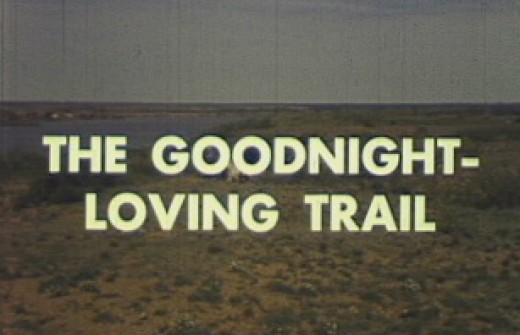
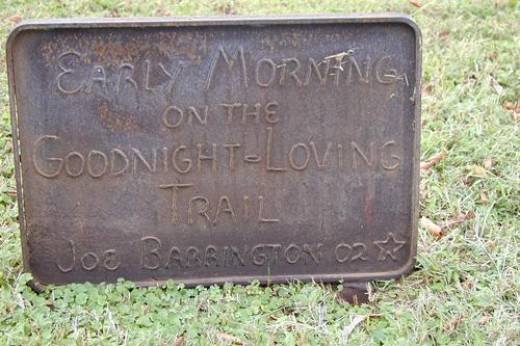
Charles Goodnight
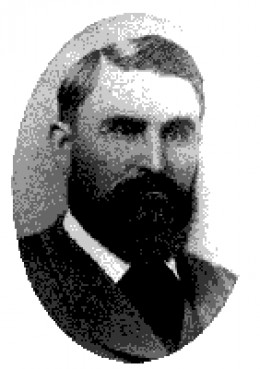
Oliver Loving
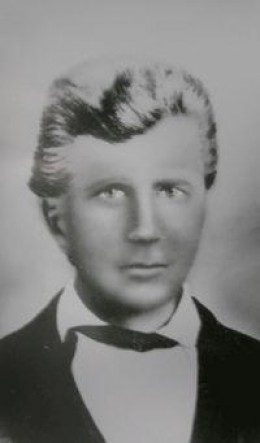
The Goodnight and Loving Trail
Long
before railroad lines and fences changed the landscape and culture of
what used to be the Wild Wild West - there was the Goodnight Loving
Trail. The frontier was wide open and free then, and it may not ever be
that way again.
Charles Goodnight was born in Illinois in 1836, and nine years later his family moved South to Texas and settled in Milam County. By the age of twenty, and with the help of some brothers, Charles was herding four hundred head of cattle at a time up to the Brazos River. During the Civil War - Charles served the Confederacy as a frontiersman, protecting settlers along the Brazos River. When Charles Goodnight returned home after the war he found that all of his family's cattle were gone, and that lawlessness due to the broken Southern economy, had taken over.
By 1866 Charles Goodnight had recovered sufficiently from the war year losses, and wanted to herd cattle for sale to the lucrative army base and mining towns in New Mexico and Colorado, but to do this he'd have to create a trail that skirted South of Comanche and Kiowa tribal territories. As he took a trip to Weatherford for supplies in preparation, he met fellow Cattleman Oliver Loving.
Oliver Loving suggested that if Goodnight were to let him, then he'd like to accompany him with his own cattle. To that suggestion Goodnight said that it would be the thing that he'd most wanted in his life - as the advice and protection of the additional entourage would surely have been twice as strong a force for folks driving huge herds of cattle through trails they planned to create whilst also trying to avoid attacks by Native Americans who, quite naturally, were sick of "white folk" trespassing their lands.
Charles Goodnight was born in Illinois in 1836, and nine years later his family moved South to Texas and settled in Milam County. By the age of twenty, and with the help of some brothers, Charles was herding four hundred head of cattle at a time up to the Brazos River. During the Civil War - Charles served the Confederacy as a frontiersman, protecting settlers along the Brazos River. When Charles Goodnight returned home after the war he found that all of his family's cattle were gone, and that lawlessness due to the broken Southern economy, had taken over.
By 1866 Charles Goodnight had recovered sufficiently from the war year losses, and wanted to herd cattle for sale to the lucrative army base and mining towns in New Mexico and Colorado, but to do this he'd have to create a trail that skirted South of Comanche and Kiowa tribal territories. As he took a trip to Weatherford for supplies in preparation, he met fellow Cattleman Oliver Loving.
Oliver Loving suggested that if Goodnight were to let him, then he'd like to accompany him with his own cattle. To that suggestion Goodnight said that it would be the thing that he'd most wanted in his life - as the advice and protection of the additional entourage would surely have been twice as strong a force for folks driving huge herds of cattle through trails they planned to create whilst also trying to avoid attacks by Native Americans who, quite naturally, were sick of "white folk" trespassing their lands.
A Texas Longhorn - Can You Imagine Herding TWO THOUSAND Of These Beasts?
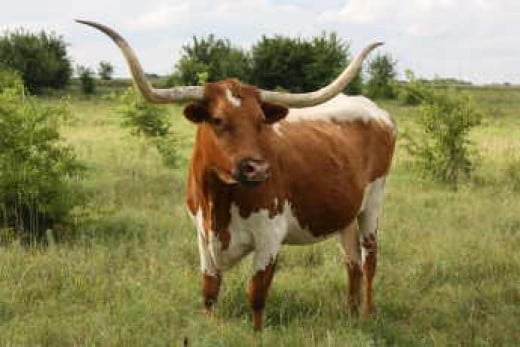
The Chuckwagon
Most
everyone in America, I'd bet, at one time or another has seen a Western
movie. Most folks here in Texas have seen so many Western themed films
that they'd never be able to recall all of them were they to make a
protracted effort of it. Almost every single Western film, if not every
single one - features at some point or another a snippet of a chuckwagon
rolling through the countryside. You can thank Charles Goodnight for
that - every single one of them.
Loving had spent the war years supplying the Confederacy with cattle. That age old aphorism that an army moves on it's stomach isn't limited to armies at all though - cowboys who herd cattle across brutal terrain are rather motivated by good food as well. Charles Goodnight agreed, of course, and bought a surplus Confederate army wagon, and outfitted it for carrying the food for the two, and the eighteen hired cowboys on their first cattle drive.
Loving had spent the war years supplying the Confederacy with cattle. That age old aphorism that an army moves on it's stomach isn't limited to armies at all though - cowboys who herd cattle across brutal terrain are rather motivated by good food as well. Charles Goodnight agreed, of course, and bought a surplus Confederate army wagon, and outfitted it for carrying the food for the two, and the eighteen hired cowboys on their first cattle drive.
A Chuckwagon
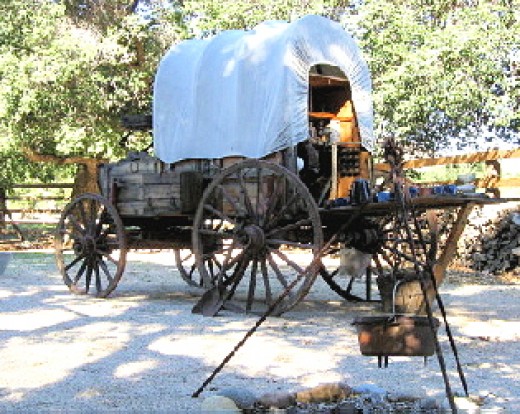
The Trans Pecos Crossing
The
Trans Pecos region of West Texas is without water at one stretch for
around 80 miles. There were only a few good places to cross the Pecos
River, and the most famous of those is a place called Horsehead
Crossing. Horsehead Crossing got it's name from the Comanche raiders
that would go into Mexico to steal horses, and when heading back to
their Comacheria, horses would often drink so much water at the Pecos
River that they would actually kill themselves from it, or sometimes get
caught in the quicksand. The skeletal heads of the horses would then be
stacked under the nearby trees.
Due to the heat and dehydration deaths of the cattle in the Trans Pecos region, only about fifteen hundred of the original two thousand cattle on the first Goodnight Loving cattle drive made it to the army and mining bases. Still, Goodnight, Loving, and the eighteen cowboys made themselves a nice hefty sum, and plans were immediately made for more cattle drives.
Due to the heat and dehydration deaths of the cattle in the Trans Pecos region, only about fifteen hundred of the original two thousand cattle on the first Goodnight Loving cattle drive made it to the army and mining bases. Still, Goodnight, Loving, and the eighteen cowboys made themselves a nice hefty sum, and plans were immediately made for more cattle drives.
Horsehead Crossing
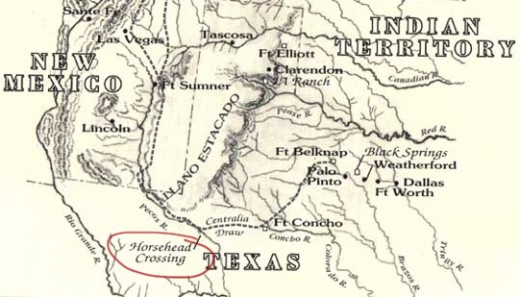
The Death of Loving
The
Goodnight and Loving cattle drive group had barely escaped with their
scalps intact many times. They'd survived several battles with Native
American Indians - but Oliver Loving would meet his match - but not
directly at the hands of the band of Apache Indians that forced him up
against a rock wall and into a gun battle - Oliver Loving fought them
off, and escaped. He floated himself six miles down the Pecos River to
another river crossing, and then lay injured for three days before some
Mexicans and a German boy found him and carried him to safety. Oliver
Loving had sustained a wound through his wrist and into his side.
Charles Goodnight put out a furious search for his partner, and found him. Loving, however, had contracted gangrene - had an arm amputated, and died. He'd made Goodnight promise to bury him in Texas near his home, and that request was certainly obliged. Goodnight, a good friend, continued to give half of his cattle drive income to the family of Oliver Loving for all cattle drives for the next two years.
Though the legendary Texas cattleman duo had ended as a team, their trail and their legend live on in the South Western United States, and indeed, throughout the rest of the world.
Charles Goodnight put out a furious search for his partner, and found him. Loving, however, had contracted gangrene - had an arm amputated, and died. He'd made Goodnight promise to bury him in Texas near his home, and that request was certainly obliged. Goodnight, a good friend, continued to give half of his cattle drive income to the family of Oliver Loving for all cattle drives for the next two years.
Though the legendary Texas cattleman duo had ended as a team, their trail and their legend live on in the South Western United States, and indeed, throughout the rest of the world.
Apache Indians
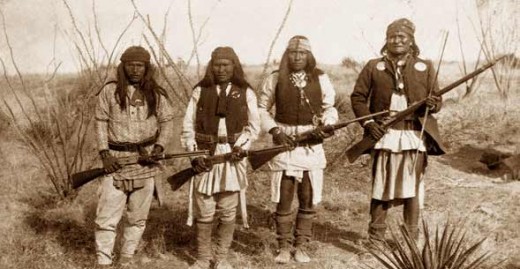
The is an OUTSTANDING PDF on The Goodnight Loving Trail
- http://cvassanangelo.org/uploads/The_Goodnight-Loving_Trail.pdf
Today, just south of San Angelo, the Middle Concho River meanders into Twin Buttes Reservoir. From there it empties into Lake Nasworthy before continuing on down to eventually merge with the Colorado River. On June 5 th , 1866 two thousand head
0 comments:
Post a Comment